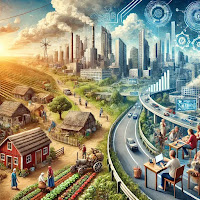FEATURES OF SOCIAL CHANGE
Society is a system of relationships and institutions that are never static. They are ever-changing. Social change refers to a change that occurs in the social organization, human interactions and interrelations and the structure and functions of society.
1. Social change is continuous:
Society is undergoing endless changes. These changes cannot be stopped. Society cannot be preserved in a museum to save it from the ravages of time. From the dawn of history down to this day, society has been in continuous flux.
2. It is temporal:
Change in anything or any object or in situation takes place through time. Time is the most important factor and social change denotes time sequence. According to Maclver, “It is a becoming, not a being; a process, not a product.” Innovation of new things, modification and renovations of the existing behaviour take time.
3. Social change is environmental:
It must take place within a geographic or physical and cultural context. Both these contexts have an impact on human behavior and in turn, man changes them. Social changes never take place in a vacuum.
4. Social change is human change:
The sociological significance of the change consists of the fact that it involves the human aspect. The composition of society is not constant, but changing the fact that people effect changes and are themselves affected by it makes change extremely important.
5. It may create a chain reaction:
Social change produces not a single reaction but chain reactions as all the parts of the society are interrelated and interdependent. For example, women's economic independence has brought changes not only in their status but also in a series of changes in the home, family relationships and marriages, etc.
6. It results from the interaction of a number of factors:
A single factor can trigger a particular change but never causes social change. It is always associated with other factors such as cultural, biological, physical, technological and others. It is due to the material interdependence of social phenomena.
7. Social change may be planned or unplanned:
Planned changes are those which occur by some deliberate or conscious effort. On the other hand, unplanned change refers to the change that occurs without deliberate efforts, like earth-quake, wars, political revolutions and other natural calamities. Thus, social change occurs both in a planned and unplanned manner.
8. Social change may bring about immediate or long-term results:
Some change brings immediate change which is known as short-term change, like fashion, behaviour of the individual, etc. But other changes take years to produce results which are known as long-term change. Custom, traditions, folkways, mores, etc. are long-term changes.
Social change refers to modifications or replacements in social structure, social process, social pattern, social interaction and social organization. It is a change in the structure and process of the entire society.





0 Comments